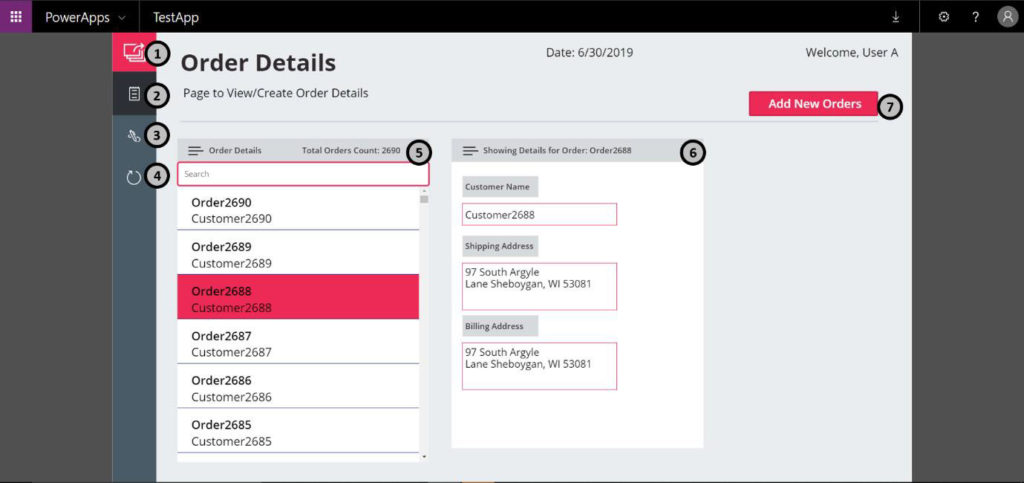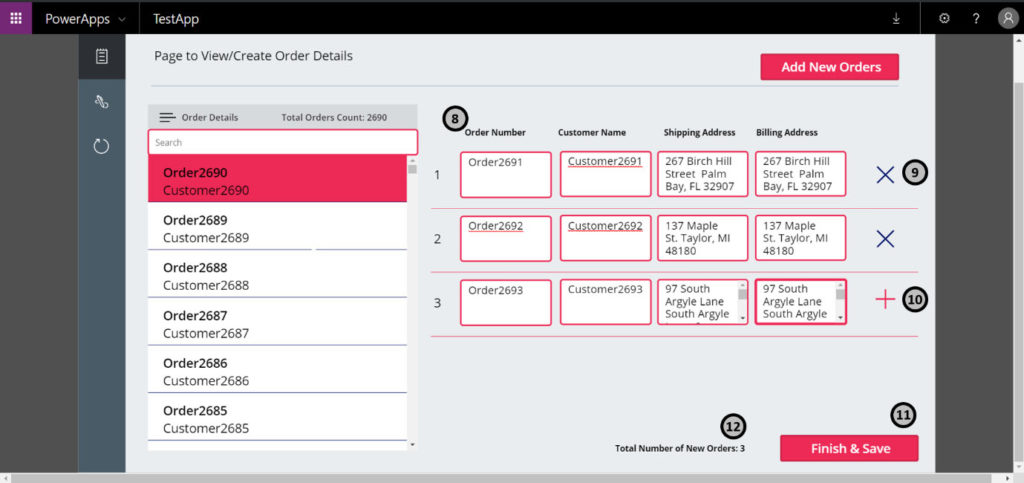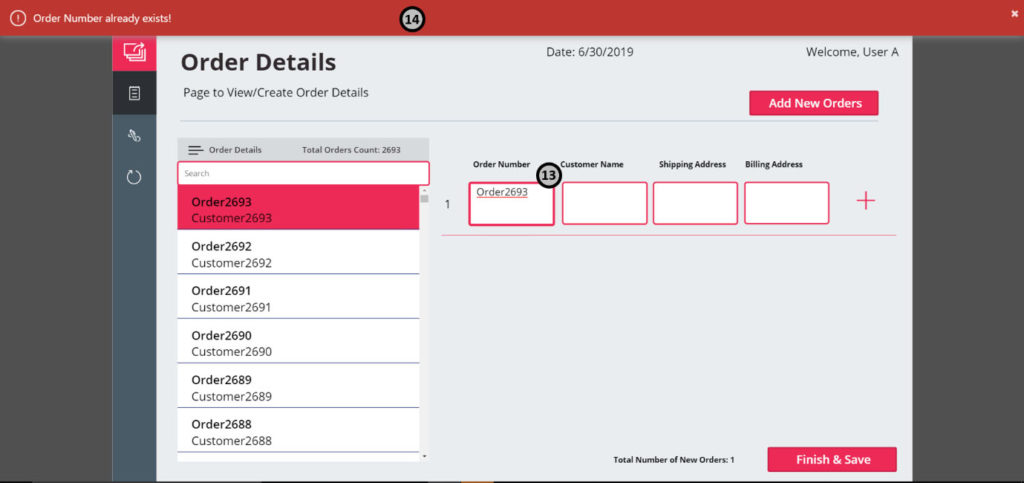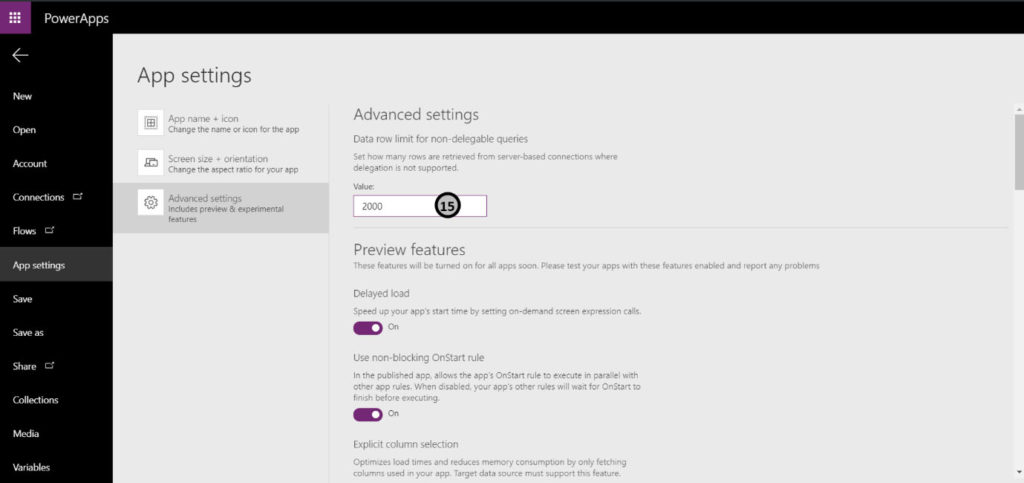How to use galleries to create dynamic entries in a data source in Power Apps
In this article, we will see how we can use galleries in Power Apps to create multiple rows for adding records to a data source. We will create dynamic entries in a gallery that looks like a form and adds/deletes a line/row with the press of a button.
Scenario: XYZ Inc. is a sales company that deals in sales of hardware components from manufacturers to retailers. User A is an on-field sales agent of XYZ Inc. and uses a static application to enter the order details from a customer. This application is further connected to a SharePoint list and creates a new item on the list whenever User A enters the detail and hits the submit button. The application provides the ability to enter only one order detail at a time and User A ends up putting more effort and time in entering those details.
We designed a customized Power App for XYZ Inc. where User A authenticates and lands on the Order Details page. User A can view all their previous entries, search for an order by entering the name of the customer, vendor, invoice number, etc. Functionality to add details is provided within the app. User A clicks the add new orders button and a form gallery is displayed. User A can add multiple records by creating new lines with the press of a button in the form gallery. A local collection with all the entries on the form is created in Power Apps. Once User A hits the “Finish & Save” button, an item for each entry is created on the SharePoint List and the Order Details gallery is updated with these newly added records.
Let’s look at the component-wise description of the controls in the app. The schema for data on the SharePoint List is:
| S.No | Column Name | Column Data Type |
|---|---|---|
| 1 | Title (Order Number) | Single Line of Text (255 Chars) |
| 2 | Customer | Single Line of Text (255 Chars) |
| 3 | Shipping Address | Single Line of Text (255 Chars) |
| 4 | Billing Address | Single Line of Text (255 Chars) |
On the App -> OnStart option, the expression used is:
ClearCollect(DynamicGallery,{Value:1}); Clear(OrderCollection); Collect(OrderCollection,Filter(OrderDets,StartsWith(Title,"Order1"))); Collect(OrderCollection,Filter(OrderDets,StartsWith(Title,"Order2"))); Collect(OrderCollection,Filter(OrderDets,StartsWith(Title,"Order3"))); Collect(OrderCollection,Filter(OrderDets,StartsWith(Title,"Order4"))); Collect(OrderCollection,Filter(OrderDets,StartsWith(Title,"Order5"))); Collect(OrderCollection,Filter(OrderDets,StartsWith(Title,"Order6"))); Collect(OrderCollection,Filter(OrderDets,StartsWith(Title,"Order7"))); Collect(OrderCollection,Filter(OrderDets,StartsWith(Title,"Order8"))); Collect(OrderCollection,Filter(OrderDets,StartsWith(Title,"Order9")))
Explanation: Here, I am creating a collection “Dynamic Gallery” and this is the number of rows corresponding to the gallery control for creating the new orders. I am creating another collection “OrderCollection” and this collection contains all the Order Details from the SharePoint List named “OrderDets”.
Note: The “StartsWith” function is not delegable if a variable is passed as the second argument which is the reason why I am using multiple “Collect” statements to iterate over all possible values.
- This icon is the Home Page icon and clicking on this navigates the user to the home screen
- This icon is the Order Details Screen icon and clicking on this navigates the user to the Order Details Screen
- This icon is the Edit an Item icon and clicking on this allows the user to edit a particular item
- This icon is the Refresh Icon and clicking on this refreshes the data source, the expression used here is:
Refresh(OrderDets);Clear(OrderCollection); Collect(OrderCollection,Filter(OrderDets,StartsWith(Title,"Order1"))); Collect(OrderCollection,Filter(OrderDets,StartsWith(Title,"Order2"))); Collect(OrderCollection,Filter(OrderDets,StartsWith(Title,"Order3"))); Collect(OrderCollection,Filter(OrderDets,StartsWith(Title,"Order4"))); Collect(OrderCollection,Filter(OrderDets,StartsWith(Title,"Order5"))); Collect(OrderCollection,Filter(OrderDets,StartsWith(Title,"Order6"))); Collect(OrderCollection,Filter(OrderDets,StartsWith(Title,"Order7"))); Collect(OrderCollection,Filter(OrderDets,StartsWith(Title,"Order8"))); Collect(OrderCollection,Filter(OrderDets,StartsWith(Title,"Order9")))
Explanation: This refreshes the data source (“OrderDets” SharePoint List). It also clears the existing data from the “OrderCollection” collection and refills it with the new data.
- This is a gallery control that populates all the items of the SharePoint list
- The expression used in the “Text” property of the “Order Details” label is:
"Order Details Total Orders Count:"&CountRows(OrderCollection)
Explanation: This expression concatenates the simple text (wrapped in “”) with the integer returned as a result of the “CountRows” function applied on the “OrderCollection” collection.
-
- The expression used in the “Items” property of the Gallery is:
Sort(Filter(OrderCollection,If(!IsBlank(TextInput3.Text),StartsWith(Title,TextInput3.Tex t) ||
StartsWith(Customer,TextInput3.Text),true)),Value(Last(Split(Title,"r")).Result),Descen ding)
- This is a stack of Text labels used to show the information when an item is selected in the “Order Details” gallery. Expressions used on the labels:
Customer: Gallery5.Selected.Customer, Shipping Address: Gallery5.Selected.'Shipping Address', Billing Address: Gallery5.Selected.'Billing Address'
Explanation: Each line is an individual expression that fetched the attributes of the item selected in the “OrderDetails” gallery (Gallery5).
- This is a button control that enables the gallery control for the user to create dynamic lines and enter the order details. Expression used on this button:
ClearCollect(DynamicGallery,{Value:1});Set(NewOrder,true);Set(ResetGallery,false);Set(ResetGallery,true)
Explanation: Here I am recreating the “DynamicGallery” collection to accommodate just one value that corresponds to one row of the newly visible dynamic control gallery. I am setting up two new variables “NewOrder” and “ResetGallery” that control the visibility/reset of this dynamic gallery control, “Total Number of New Orders” and the “Finish and Save Button” controls.
- This is the dynamic gallery control that I customized for user inputs. This gallery control has four text input controls to get the values for each of the attributes of the SharePoint List. The user can create multiple lines (one at a time) to add multiple records in one go. Data from each line is directly patched to the data source to create a new item. The user can remove the line by clicking the “X” icon. Configuration of the elements of the gallery control:
Gallery Properties:
Items: DynamicGallery, Visible: NewOrder,
Explanation: “DynamicGallery” is the collection that holds count of the orders to be added. “NewOrder” is a variable used to set the visibility of the controls.
- This icon is to remove the current row from the dynamic gallery. The expression used on this is:
Icon Properties:
OnSelect: Remove(DynamicGallery,ThisItem), Visible: If(ThisItem.Value <>
Last(Sort(DynamicGallery,Value,Ascending)).Value,true,false)
Explanation: We are removing the current item from the gallery by pressing this button (“OnSelect”) property. This icon’s visibility is set in a way that it shows up only if the current row is not the last item of the dynamic gallery.
- This icon is to add a new row/ line to the dynamic gallery. The expression used on this is:
Icon Properties:
OnSelect: Collect(DynamicGallery,{Value: ThisItem.Value + 1}), Visible: If(ThisItem.Value =
Last(Sort(DynamicGallery,Value,Ascending)).Value,true,false)
Explanation: We are adding a row/line by adding an item to the dynamic gallery collection by pressing this button (“OnSelect”) property. This icon’s visibility is set such that it shows up only on the last item of the dynamic gallery.
- This button is to perform the patch action on the “OrderDets” SharePoint List and it patches all the entries made by the User A in the dynamic gallery. The expression used in this control is:
ForAll(
Gallery3_1.AllItems,
Concurrent(
Patch(OrderDets,Defaults(OrderDets),{Title:TextInput2_6.Text,Customer:TextInput2 _7.Text,'Shipping Address':TextInput2_4.Text,'Billing Address':TextInput2_5.Text}), Patch(OrderCollection,Defaults(OrderCollection),{Title:TextInput2_6.Text,Customer: TextInput2_7.Text,'Shipping Address':TextInput2_4.Text,'Billing
Address':TextInput2_5.Text})));
ClearCollect(DynamicGallery,{Value:1});
Set(NewOrder,false);
Refresh(OrderDets)
Explanation: In this control, the concurrent function executes two patch commands, one in the data source (“OrderDets” SharePoint List) and the other on the local collection (“OrderCollection”) based on the inputs by the User A in each of the line/ row of the dynamic gallery. The “DynamicGallery” collection is being reset to hold a single value. The variable “NewOrder” is set to “false” to toggle the visibility of the dynamic gallery and then we finally refresh the data source.
Note: We are doing a concurrent patch instead of refreshing and recollecting the data in the collection “OrderCollection” from the data source to optimize the operations in the app.
- This is the text label control that displays the total number of current lines/rows User A has created. The expression used here is:
"Total Number of New Orders: "& CountRows(Gallery3_1.AllItems)
Explanation: Here the text “Total number of New Orders” is being concatenated with the number of rows of the dynamic gallery.
- This is the text input control of the dynamic gallery. Here I am validating the text input and checking through the “OrderCollection” if the entered Order Number already exists. If it exists, the user will get an error notification. The expression used in the “OnChange” property of this control is:
If(TextInput2_6.Text in OrderCollection.Title,Notify("Order Number already exists!",NotificationType.Error))
Explanation: Here the if condition checks if the text of the text input control exists in the “Title” column of the “OrderCollection” collection and pops an error message if the condition is met.
- This is the error notification generated when the user enters an existing order number in the text input.
- This is the App settings page of the app where we are increasing the soft limit of the data row limit on of non-delegable queries from 500 to 2000.
In this article, I have shown a basic implementation of the dynamic galleries concept and the multiple items/ records patch function for a SharePoint data source. This can be replicated with minor changes in the expressions for other data sources such as CDS, excel, SQL, etc.
I hope you found this interesting and it helped you. Thank you for reading!










